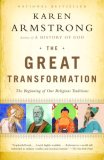Summary | Excerpt | Reading Guide | Reviews | Beyond the Book | Readalikes | Genres & Themes | Author Bio

Critics' Opinion:
Readers' Opinion:
First Published:
Mar 2006, 496 pages
Paperback:
Apr 2007, 560 pages
 Book Reviewed by:
Book Reviewed by:
BookBrowse Review Team
Buy This Book
The Avestan Aryans called their gods daevas ("the
shining ones") and amesha ("the immortals"). In
Sanskrit these terms became devas and amrita.
None of these divine beings, however, were what we usually
call "gods" today. They were not omnipotent and had no
ultimate control over the cosmos. Like human beings and all
the natural forces, they had to submit to the sacred order
that held the universe together. Thanks to this order, the
seasons succeeded one another in due course, the rain fell
at the right times, and the crops grew each year in the
appointed month. The Avestan Aryans called this order
asha, while the Sanskrit-speakers called it rita.
It made life possible, keeping everything in its proper
place and defining what was true and correct.
Human society also depended upon this sacred order. People
had to make firm, binding agreements about grazing rights,
the herding of cattle, marriage, and the exchange of goods.
Translated into social terms, asha/rita meant
loyalty, truth, and respect, the ideals embodied by Varuna,
the guardian of order, and Mithra, his assistant. These gods
supervised all covenant agreements that were sealed by a
solemn oath. The Aryans took the spoken word very seriously.
Like all other phenomena, speech was a god, a deva.
Aryan religion was not very visual. As far as we know, the
Aryans did not make effigies of their gods. Instead, they
found that the act of listening brought them close to the
sacred. Quite apart from its meaning, the very sound of a
chant was holy; even a single syllable could encapsulate the
divine. Similarly, a vow, once uttered, was eternally
binding, and a lie was absolutely evil because it perverted
the holy power inherent in the spoken word. The Aryans would
never lose this passion for absolute truthfulness.
Every day, the Aryans offered sacrifices to their gods to
replenish the energies they expended in maintaining world
order. Some of these rites were very simple. The sacrificer
would throw a handful of grain, curds, or fuel into the fire
to nourish Agni, or pound the stalks of soma, offer the pulp
to the water goddesses, and make a sacred drink. The Aryans
also sacrificed cattle. They did not grow enough crops for
their needs, so killing was a tragic necessity, but the
Aryans ate only meat that had been ritually and humanely
slaughtered. When a beast was ceremonially given to the
gods, its spirit was not extinguished but returned to Geush
Urvan ("Soul of the Bull"), the archetypical domestic
animal. The Aryans felt very close to their cattle. It was
sinful to eat the flesh of a beast that had not been
consecrated in this way, because profane slaughter destroyed
it forever, and thus violated the sacred life that made all
creatures kin. Again, the Aryans would never entirely lose
this profound respect for the "spirit" that they shared with
others, and this would become a crucial principle of their
Axial Age.
To take the life of any being was a fearful act, not to be
undertaken lightly, and the sacrificial ritual compelled the
Aryans to confront this harsh law of existence. The
sacrifice became and would remain the organizing symbol of
their culture, by which they explained the world and their
society. The Aryans believed that the universe itself had
originated in a sacrificial offering. In the beginning, it
was said, the gods, working in obedience to the divine
order, had brought forth the world in seven stages. First
they created the Sky, which was made of stone like a
huge round shell; then the Earth, which rested like a
flat dish upon the Water that had collected in the
base of the shell. In the center of the Earth, the gods
placed three living creatures: a Plant, a Bull,
and a Man. Finally they produced Agni, the Fire.
But at first everything was static and lifeless. It was not
until the gods performed a triple sacrifice—crushing the
Plant, and killing the Bull and the Man—that the world
became animated. The sun began to move across the sky,
seasonal change was established, and the three sacrificial
victims brought forth their own kind. Flowers, crops, and
trees sprouted from the pulped Plant; animals sprang from
the corpse of the Bull; and the carcass of the first Man
gave birth to the human race. The Aryans would always see
sacrifice as creative. By reflecting on this ritual, they
realized that their lives depended upon the death of other
creatures. The three archetypal creatures had laid down
their lives so that others might live. There could be no
progress, materially or spiritually, without self-sacrifice.
This too would become one of the principles of the Axial
Age.
Excerpted from The Great Transformation by Karen Armstrong Copyright © 2006 by Karen Armstrong. Excerpted by permission of Knopf, a division of Random House, Inc. All rights reserved. No part of this excerpt may be reproduced or reprinted without permission in writing from the publisher.





The House on Biscayne Bay
by Chanel Cleeton
As death stalks a gothic mansion in Miami, the lives of two women intertwine as the past and present collide.

The Flower Sisters
by Michelle Collins Anderson
From the new Fannie Flagg of the Ozarks, a richly-woven story of family, forgiveness, and reinvention.

The Funeral Cryer by Wenyan Lu
Debut novelist Wenyan Lu brings us this witty yet profound story about one woman's midlife reawakening in contemporary rural China.
Your guide toexceptional books
BookBrowse seeks out and recommends the best in contemporary fiction and nonfiction—books that not only engage and entertain but also deepen our understanding of ourselves and the world around us.